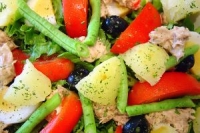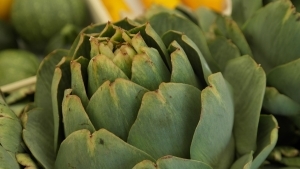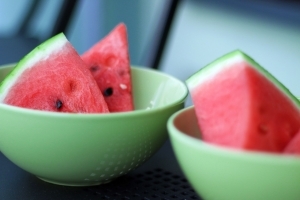Butterflied Leg of Lamb with Preserved Lemon
Serves 6 (or 8, or more if using a larger piece of meat)
Preserved lemon and spices really work their magic on lamb, giving it a piquant sweetness.
Ingredients
- 700 g (about 1¼ lb) butterflied leg of lamb
- 1 preserved lemon
- 2 Tbsp extra virgin olive oil
- ½ tsp each cumin and fennel seeds
- 1 tsp coriander seeds
- 1 tsp ras el hanout
- ¼ tsp freshly ground black pepper
- 1 tsp flaky sea salt, plus extra for sprinkling
- 2 cloves garlic, thinly sliced
Method
Preheat oven to 210°C (410°F). Trim away any excess fat from lamb. Rinse preserved lemon under running water, discarding pulp. Pat rind dry with paper towels and slice thickly. Combine lemon, oil, spices, pepper, salt and garlic together. Rub spice paste all over lamb. Cover lamb loosely (I use a sheet of baking / parchment paper and a food umbrella) and marinate at room temperature for 1 hour. The lamb can be prepared several hours before cooking — but cover well and refrigerate — and remember, it’s essential to bring the lamb to room temperature before cooking.
Transfer lamb to a shallow roasting tin, fat side up. Tuck garlic and lemon into any crevices in lamb to prevent them burning, or tuck under meat. Roast for 12 minutes for a small piece of lamb (see Recipe Notes).
Remove from oven, season with salt, then rest lamb for 10–12 minutes before slicing thinly with a long, sharp knife. Arrange on a warmed platter. Skim off any fat from roasting juices then spoon them over the sliced lamb. Serve immediately.
Recipe Notes
If cooking a bigger piece of meat, allow a little longer in the oven. For a 1.3 kg (roughly 2¾ lb) butterflied leg of lamb, cook for 25 minutes. If cooking on fanbake, cook at 200°C (400°F). See more information about cooking meat on page 194.
I love the lamb with a tray of roasted fennel, yellow and red pepper (bell pepper / capsicum), eggplant (aubergine) and carrot, sprinkled with pomegranate seeds and served with a bowl of thick yoghurt jazzed up with crushed garlic, chopped mint and ground cumin. There’s so much flavour there already, but if you want to go right over the top, drizzle with pomegranate molasses. It’s also delicious cold — but be warned, the leftovers won’t last long!
Barbecue Instructions
You’ll get a great result cooking the lamb in the oven, but in summer I love it cooked on a barbecue hot plate (cast-iron griddle) because it develops a deep golden crust and an extra layer of flavour as the spices are driven in by the heat. You’ll need a hooded barbecue for this.
Preheat the barbecue hot plate (cast-iron griddle) on high for 10 minutes (hood up). Scrape the garlic and lemon rind off the lamb and reserve it. Put the lamb skin side down and let it cook for 2–3 minutes only, until it has started browning nicely. I usually put the garlic and lemon on the meat so it starts to flavour the lamb. Don’t wander off or you’ll end up forgetting the lamb and burning it (I speak from experience!), then turn the barbecue to low and cook for 25 minutes only with the hood down BUT you will need to turn the lamb about halfway through (first scraping the garlic and lemon onto the hot plate). Put the hood down again, but check on the garlic and lemon and move them to a side plate as soon as they are browned. For a small piece of lamb, cook for about 12 minutes only or use the ‘touch test’ as described on page 120.


